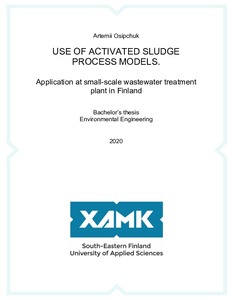Use of activated sludge process models. Application at small-scale wastewater treatment plant in Finland.
Osipchuk, Artemii (2020)
Osipchuk, Artemii
2020
All rights reserved. This publication is copyrighted. You may download, display and print it for Your own personal use. Commercial use is prohibited.
Julkaisun pysyvä osoite on
https://urn.fi/URN:NBN:fi:amk-2020091120366
https://urn.fi/URN:NBN:fi:amk-2020091120366
Tiivistelmä
Mathematical modelling of the Activated Sludge Process (ASP) has gained close attention as a valuable tool in the wastewater treatment during the last decades. Modelling is widely applied at large-scale Wastewater Treatment Plants (WWTPs) for design, optimisation, research and control using simulation software based on standardised mathematical models such as the Activated Sludge Model (ASM) family. However, the application of modelling at small-scale WWTPs is uncertain due to a procedure complexity and local use cases.
Lapinjärvi is a small Finnish municipality in the Uusimaa region with three small-scale operating WWTPs. The topic of the study is the largest one, the Kirkonkylä WWTP. The current treatment process does not achieve favourable cleaning results due to ageing equipment and an outdated operation approach. The municipality needs a new method for the process control of operating WWTPs and planning a new WWTP.
The focus of this study is an evaluation of modelling applicability at a small-scale WWTP. The possibility of WWTP model simulation with data limited to the conventional construction and operational data is considered. The results of the steady-state simulation and possible applications are demonstrated in practice.
In this work, the developed model of the Kirkonkylä WWTP with oxidation ditch configuration of the ASP is described. The model of the plant is built on the base of the Activated Sludge Model No. 1 (ASM1) combined with the Takács model based on the model of Vitasovic for the secondary settling tank. The plant model and simulations are completed in the WEST 2017 SP 1 software environment released by MIKE Powered by DHI.
Lapinjärvi is a small Finnish municipality in the Uusimaa region with three small-scale operating WWTPs. The topic of the study is the largest one, the Kirkonkylä WWTP. The current treatment process does not achieve favourable cleaning results due to ageing equipment and an outdated operation approach. The municipality needs a new method for the process control of operating WWTPs and planning a new WWTP.
The focus of this study is an evaluation of modelling applicability at a small-scale WWTP. The possibility of WWTP model simulation with data limited to the conventional construction and operational data is considered. The results of the steady-state simulation and possible applications are demonstrated in practice.
In this work, the developed model of the Kirkonkylä WWTP with oxidation ditch configuration of the ASP is described. The model of the plant is built on the base of the Activated Sludge Model No. 1 (ASM1) combined with the Takács model based on the model of Vitasovic for the secondary settling tank. The plant model and simulations are completed in the WEST 2017 SP 1 software environment released by MIKE Powered by DHI.
